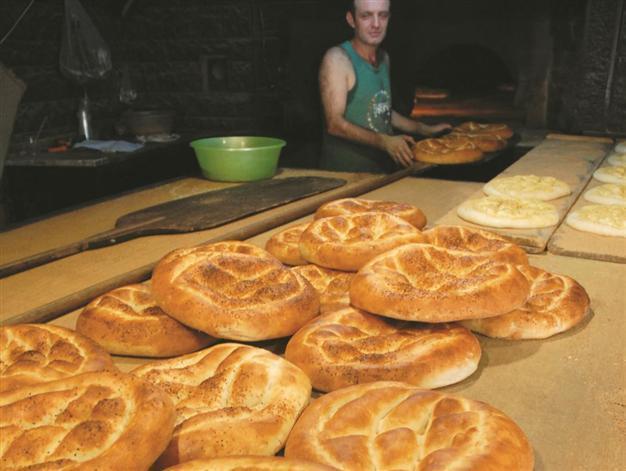Fast and feast
Aylin Öney Tan

Who can resist fresh pide from the oven?
Fresh pide from the oven, still lovingly warm… Plumb succulent dates and glistening black olives waiting side by side in little pretty plates. Home-made jewel-like jams and honey in comb next to morsels of cheese. Thirst-quenching glasses of tamarind sherbet. Alas, it is not the time to eat or drink… Everybody is silently and patiently waiting for the sound of the cannon or the call from the minaret to break the fast. This must be the most difficult moments of a typical day in Ramadan, the last minutes of a long day of fasting just before the feast of iftar. Not to take a sip of water, or have bite from the table requires real self-restraint. This is the moment to appreciate the blessings of God and the food.İftar, as a word comes from the root “fatr” in Arabic and means to break open or to cut; in Turkish it strictly means to break the Ramadan fast. In Ottoman times, iftar started with a “breakfast” (in the etymological sense of the term), followed by a proper iftar feast later at night within a couple of hours after breaking the fast. People would have little to eat as a breakfast, and quench their thirst and whet their appetite (regulate their blood sugar), go and pray (medicate and exercise) and return to eat a proper meal. That way it was way healthier than indulging in huge quantitates of food after many hours of not eating and drinking.
Eventually the iftar breakfast and the feast emerged into one big iftar feast. Nowadays, the breakfast phase survives in “iftariyelik,” sort of a first course of appetizers or amuse-bouche before the dinner. İftariyelik almost always has two essential items, dates and olives, both mentioned in the Quran. Then there is the usual breakfast items, such as honey and assorted jams, clotted cream or butter, pastırma, the cured dried beef, and a few types of cheeses. Pastırma is somehow obligatory as part of iftariyelik, perhaps because it is the most expensive and praised Turkish charcuterie specialty. The spread may have more elaborate editions like little böreks or baked savory delicacies. The iftar breakfast or iftariyelik is definitely accompanied by warm pide, a special flat bread that is made only during the month of Ramadan. Once, the iftar breakfast used to have fried eggs like a typical breakfast. This tradition survived later as an egg course served as a warm entrée. This fried egg dish could be with minced meat, with pastrami, with spinach or the most glorious and holy of all, with dates.
The real iftar dinner only started after these initial entrées, always with a soup course, then böreks (savory pies), followed by meat and poultry dishes, rice pilaff, with a fruit compote as accompaniment (for cleansing the palate like a sorbet) and sometimes more food like vegetables, and finally the desserts. Throughout the courses, fragrant sherbets were served, some made with fruits, some flavored with flowers or spices. The night was continued with more eating, praying, entertaining, music playing, more sherbets and sweets. Street vendors around mosques offered plenty, and doors of big mansions were kept open with feast tables open to all set in courtyards. Ramadan nights during the summer were like continuous feasts open-air, people continuing to wander around all night long. During Ramadan every night was a feast until it was dawn again to start fasting, to wait patiently for the next time to admire the blessings of God.
Recipe of the Week: Eggs with dates can be an interesting new dish to include in your breakfast, brunch or iftar, even if you don’t fast, but prefer to feast. The sweet and savory combination will add a new dimension to your table, totally in line with Ramadan flavors. Pit two or three dates per egg and slice them lengthwise into quarters. Fry date slices for a few minutes in butter or preferably ghee. Salt and pepper to taste. Remember good-quality, freshly ground black pepper is essential for this dish. You may prefer to add a pinch of cinnamon too. Break one or two eggs per person; I personally like to keep one intact, and scramble the other into the fried dates. Sprinkle an additional modest pinch of salt and pepper on the yolks. Once the whites are set, serve immediately with warm Ramadan pide. The most delicious bite is to dunk the pide morsels in yolks and melted butter, and eat with a few pieces of dates. Divine!
Bite of the week
Fork of the Week: Most hotels and restaurants have enormously large iftar buffets. The selection of food is endless, and sometimes a bit over the top, contradicting the initial concept of fasting and abstaining from food. The right one is hard to choose from such a selection but there are more modest options. They all claim to serve real Ottoman feasts, however, few pay attention to the historic context and Ottoman traditions.
The iftar menu at Asitane in Kariye Hotel pays attention to detail, and offers a selection of wisely chosen dishes from Ottoman cuisine. The menu includes most of the highlights of their usual menu plus Ramadan specialties, a carefully selected iftariye breakfast but minus the egg dishes as it is summer. Of course you can always ask for an extra of eggs with dates; Asitane was once the sole restaurant offering this long forgotten dish. Their iftar has also live Ottoman music; check their menu and decide: http://www.asitanerestaurant.com/English/ramadan.php
Cork of the Week: Sherbet-making is a dying tradition. Tamarind sherbet used to be the most traditional, but nowadays it is so hard to find one, and a good one is almost impossible to spot. The one in Asitane is really good with the right balance of sweetness and acidity. For spicy and fragrant sherbets, there are newly launched Ramadan sherbet editions of some soft drink and juice brands. Try the Hasbahçe series of Dimes, one of the leading brands in fruit juices.












